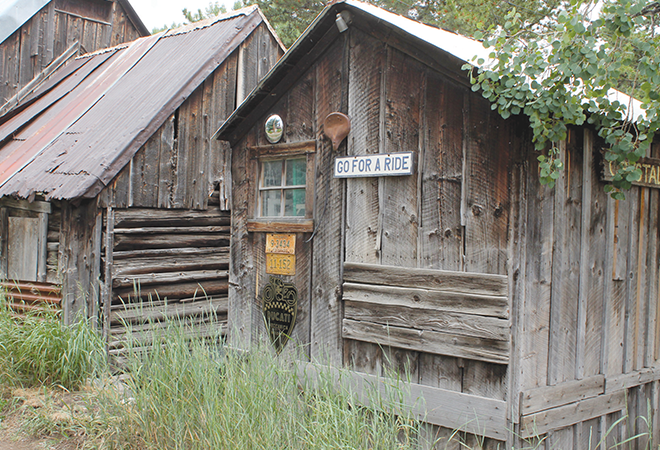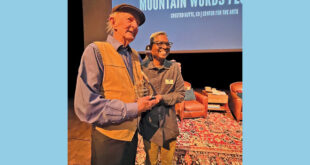Story and photos By Rob Korotky
(Editor’s Note: Like Rob, I too love the local alleys in the summer. So I didn’t want to run this in a summer issue for fear it would draw more people to one of the town’s remaining secrets. But it is February and a taste of summer is appropriate. —Mark Reaman)
Crested Butte’s past fascinates me, from its roots as a mining town to its transition into a remote ski destination, to its place in early mountain biking lore. Last summer, when I wasn’t busy working or mountain biking, I was indulging in local history. I visited sites of the old mines and sought out every historic building I could find. It’s remarkable how many historic structures along Elk remain standing as a testament to traditional main street America, even though they are occupied by newer businesses catering to a flood of tourists and outdoor enthusiasts. We all know these places—Tony’s Conoco, the old Company Store that’s now the Secret Stash, Kochevar’s, The Princess and countless others.
One day, while riding my townie in search of the foundation of the Big Mine and then to find the original Train Depot, something interesting struck me. The dirt alleys behind the businesses and houses are dripping with the character of old Crested Butte.
Like a window into the past, if not a time capsule altogether, Crested Butte’s back alleys are rich in small stories of this town and its culture. You find decaying mining sheds and rustic garages adorned with artifacts from decades gone by. Old mining tools, signs and skis hang on weathered barn wood walls, while the occasional rusting bike leans against a worn-out timber fence. And if you look hard enough you might discover relics from past Chainless Races or Vinotoks.
After Crested Butte’s side roads were paved 38 years ago the alleys became the only remaining dirt roads in town. Pockmarked with mud puddles and lined by weeds, today these pathways are where old Colorado mountain town life feels unchanged. They are gateways to back porches and nooks where residents hang out and drink a beer. They lead to driveways with broken-down dirt bikes, old townies and snowmobiles tucked away in the summer.
Peak season days on Elk Avenue can be busy and bustling like a shopping mall, but you won’t find tourists with their waffle cone from Third Bowl perusing the back alleys. For the most part, this is the zone of the locals and the territory of the people who live here and keep the town running. The alleys are where Crested Butte’s inhabitants enter and exit their jobs though back doors, take a smoke break, vent their frustrations or celebrate small victories. It’s the back of the Eldo, of Big Al’s, of the Wooden Nickel. Here you might witness a couple business owners chatting or a cook talking with his girlfriend who’s parked in an old Ford pickup truck. This is the real Crested Butte, the dusty and authentic arteries of a mountain town.
When it comes to the actual stuff to be seen in the back alleys, I’m personally fascinated by the old sheds made of oil-stained wood and corrugated metal roofs. My first time in Crested Butte was 1980 when I was just a snot-nosed kid. I don’t remember much from that trip, but one image that stuck in my head was an old shack on a side street covered in license plates. My dad laughed and said something like “Look at what this guy used for siding on his house.”
Today we know that old shack as Camp 4 Coffee and it is truly a Crested Butte icon. But stroll the back alleys of Crested Butte today and you still find countless vestiges similar to Camp 4. They may not be covered in old license plates, but each has a character and connection to the past all its own. I suspect some of these buildings were old mining shacks, while others were old garages or out-buildings that got moved and repurposed. I can’t help but wonder what stories these little buildings would tell if only they could talk.
With Vail’s purchase of the ski area and the booming real estate development currently under way, I am worried that even the back alleys might soon fade into the past. Will they eventually be paved in anticipation of greater commerce and ease of trash collection? How much longer until everything in this amazing little town is fully transformed into the next Telluride? Hopefully a long time, or not ever.
For now I will go out of my way to ride my townie down the alleys and indulge in Crested Butte’s history. Maybe this article will inspire you to take a walk down these dirt pathways with a new appreciation for the treasures they hold. If you do, don’t be surprised when you see me snapping more pictures.
Rob Korotky is a Colorado native who spends as much time in Crested Butte as he can. He’s ridden in the Pearl Pass Tour several times, climbed most of the local mountains and even crashed on the Chainless. Last summer, to fulfill one of his life dreams, he lived and worked in Crested Butte.
 The Crested Butte News Serving the Gunnison Valley since 1999
The Crested Butte News Serving the Gunnison Valley since 1999





